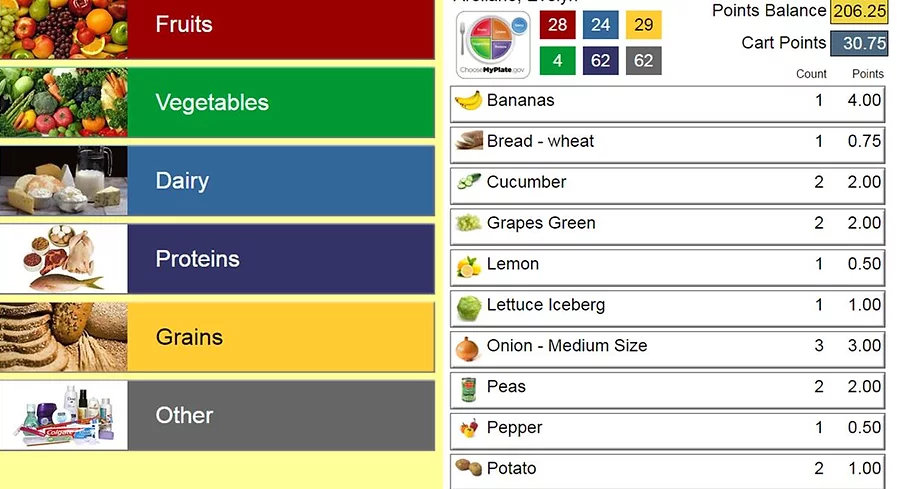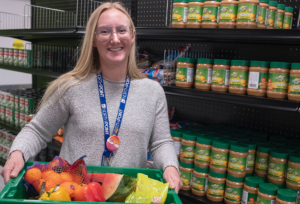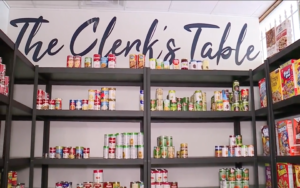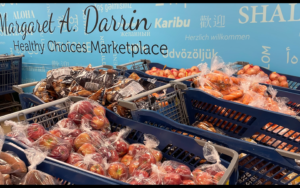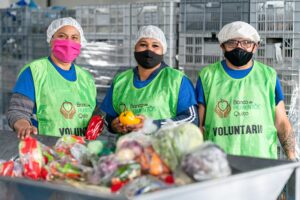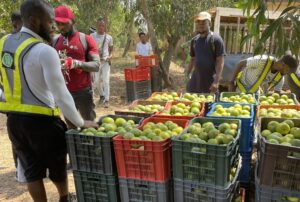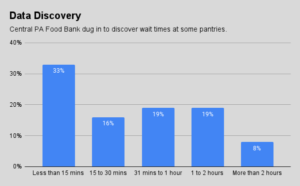More food pantries are finding reasons to love online ordering.
Online ordering systems empower clients to choose their food in a high-tech format, just as they would through Instacart, giving them a more dignified and convenient way to access charitable food. It’s a big step up from more traditional “grab-and-go” approaches, where clients pick up pre-packaged bags.
“Not only are you giving people access to the nutrition that they need, you’re doing it in a way that is socially acceptable, and it mirrors the way that all of us have learned to get our food, especially during the pandemic,” said Julie LaFontaine, President and CEO of The Open Door of Gloucester, Mass.

The Open Door implemented its online ordering system in response to the pandemic and launched it in June 2021. In just six months of using the online system, it served 8,500 individuals with roughly 2.2 million pounds of food. A key goal of the service is empowerment, LaFontaine said. Anytime the client is given the opportunity to choose, they’re empowered, she said.
The Open Door has a mix of staff members and volunteers that aid in fulfilling the orders placed online. A team of six works exclusively in the fulfillment center, alongside the warehouse team and the food acquisition team.
“Parallel to the fulfillment center, we created a whole department of dispatch workers who will assist people over the phone in placing their orders,” LaFontaine said. “We have multilingual staff in the dispatch center, as well as an on-demand translation service that will assist people in more than 170 different languages.”
The Open Door is one of about 80 pantries in 22 states using software from SmartChoice to power online ordering. In addition to providing the front-end interface for clients, the SmartChoice software helps with managing pantry operations.
“SmartChoice manages their inventory in real time, which, for food pantries, is a really complicated task because what they have in-stock changes all the time and it’s so important to be able to give their shoppers choice,” said Keri Edwards, President of SmartChoice.
SmartChoice has been available for eight years, and saw its utility soar during the pandemic. “It became very clear that in order to continue to connect people to good food, to continue to make equitable access for people, we needed to offer a way for people to get their groceries that was safe and allowed them to shop from the privacy of their own home,” Edwards said.

In Naperville, Ill., Loaves and Fishes Community Services has introduced an online ordering service that it plans to make available to other pantries. It created the system along with software developer PantryEasy. “We do not own the technology behind it because we felt we wanted to be able to offer it to other food pantries that wanted to use the site,” said Janet Derrick, Executive Vice President of Programs. “Anyone should be able to offer this program.”
Loaves and Fishes turned to online ordering in response to the pandemic. “Other people were doing the grocery pre-pack so we wanted to be able to offer an opportunity for choice for people who were still uncomfortable about shopping in the market,” Derrick said.
Since the launch of the program in early March, Loaves and Fishes has served 213 distinct households with 701 residents and scheduled 688 pickups. With 866 active volunteers, they’re able to fill 80 orders a week in their community.
“We have been able to engage more people and they’re fairly consistent on ordering,” she said. “There seems to be many repeat customers coming back.”
Catholic Charities of Central and Northern Missouri made food accessibility its mission when it opened in January. Online ordering “really gave us an opportunity to be able to reach more people and increase access to healthy food,” Food Programs Coordinator Lori Stoll said. “Our model is really centered around healthy food choices and having online ordering gives people more access so they can have more choice and select healthier foods.”
The pantry, which also uses the SmartChoice software, requires clients to place orders between 24 and 48 hours in advance so volunteers have ample time to pack the orders. “They’re not just going to a pantry and picking up a box of stuff that they may or may not use. Even if they have someone else picking it up, they’ve been able to have a say in what gets into their home and into their bodies.”
While not many clients are using the online option yet, Stoll predicts that will change soon. Currently, clients are enjoying doing in-person shopping at the pantry, which resembles a grocery store, allowing clients to come in and shop for food off shelves while socializing with customers and staff, a privilege stolen by the pandemic.
“Since we’re in this somewhat post-COVID time and people haven’t been able to gather, they are really still liking to gather and be together and be able to make their selections,” Stoll said. “Once the novelty of actually having this grocery store-type model wears off, there’ll be more [online] orders.” Stoll also expects more people will be drawn to the service once the pantry implements free food delivery through DoorDash.
Not everything has been smooth about the pantry’s entry into online ordering. When it first launched its program, clients were given membership cards with QR codes that would bring them to the ordering site. However, an incorrect code was printed on the cards, prompting the pantry to temporarily halt online operation until March, when it relaunched. – Adrianna Pray
Adrianna Pray is a first-year journalism student at Emerson College. In addition to Food Bank News, she writes for Emerson College’s student newspaper, the Berkeley Beacon.
CAPTION ABOVE: An example of an online ordering screen, through SmartChoice.
This article was made possible by the readers who support Food Bank News, a small, editorially independent 501(c)(3) nonprofit media organization. Food Bank News is not funded by any government agencies, nor is it part of a larger association or corporation. Your support helps ensure the continuation of our solutions-oriented coverage of best practices in hunger relief. Thank you!
Support Food Bank News